It is difficult to imagine the fear a shipwreck survivor would experience when surrounded by nothing but open ocean and watching your boat slowly sink with little or no resources to support your chances of survival. Lessons can be learned from successful sailors, adventurers, and explorers who possessed the proper techniques and tools to stay alive under the most trying of circumstances.
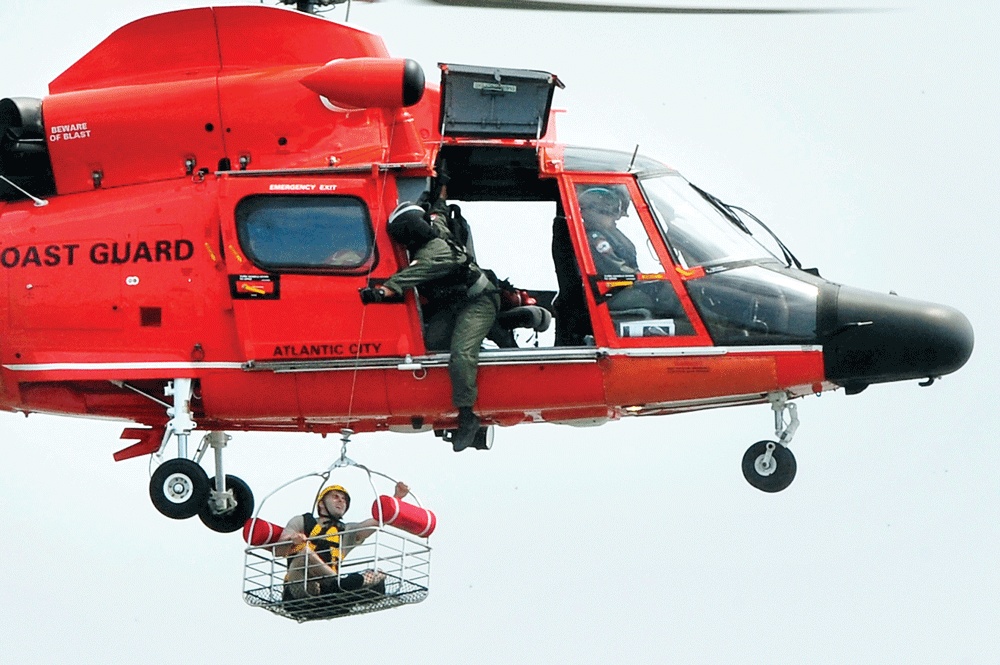
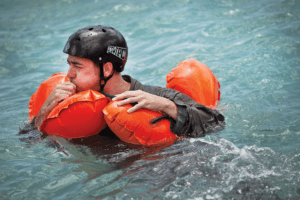
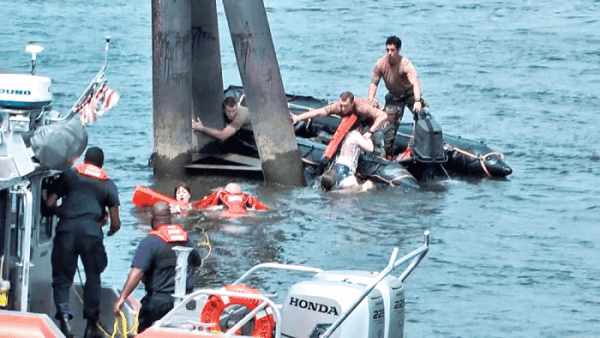
To prepare yourself to be successful, a survivalist must acquire the skills and knowledge necessary to respond in an ocean borne life and death situation. First and foremost, a sailor must have a robust knowledge of seamanship, knowledge of your vessel, weather forecasting and signaling that attracts rescue or pinpoints your location. These are fundamental requirements simply for reliable sailing, however to be successful in dire circumstances more knowledge is necessary. Critically important are methods of procuring water at sea, ways of getting food, navigational methods and how to get underway if you vessel is capable. During an incident you may be injured and so you must know how to address traumatic or environmental injuries, and maintaining an awareness of the wildlife that could be dangerous to you. Make no mistake, time spent learning these life saving techniques will appear very well spent in a real-life emergency.
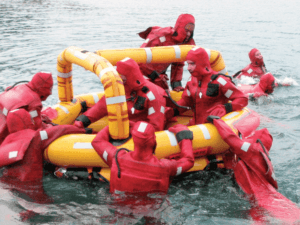
“SURVIVAL CAN BE SUMMED UP IN THREE WORDS — NEVER GIVE UP. THAT’S THE HEART OF IT REALLY. JUST KEEP TRYING.”
HAVE A PLAN
Before any incident occurs, it is critical to have a survival plan, as it is almost impossible to think of everything that needs to be accomplished as a craft is sinking. Once the plan is written down, practice the procedures. The emergency plan should include information regarding all of the subject matter in the preceding paragraph, as well as procedures for free swimming if no craft is available. If a survivalist does not have a life raft or emergency craft, treading water and staying afloat as long as possible becomes a critical skill.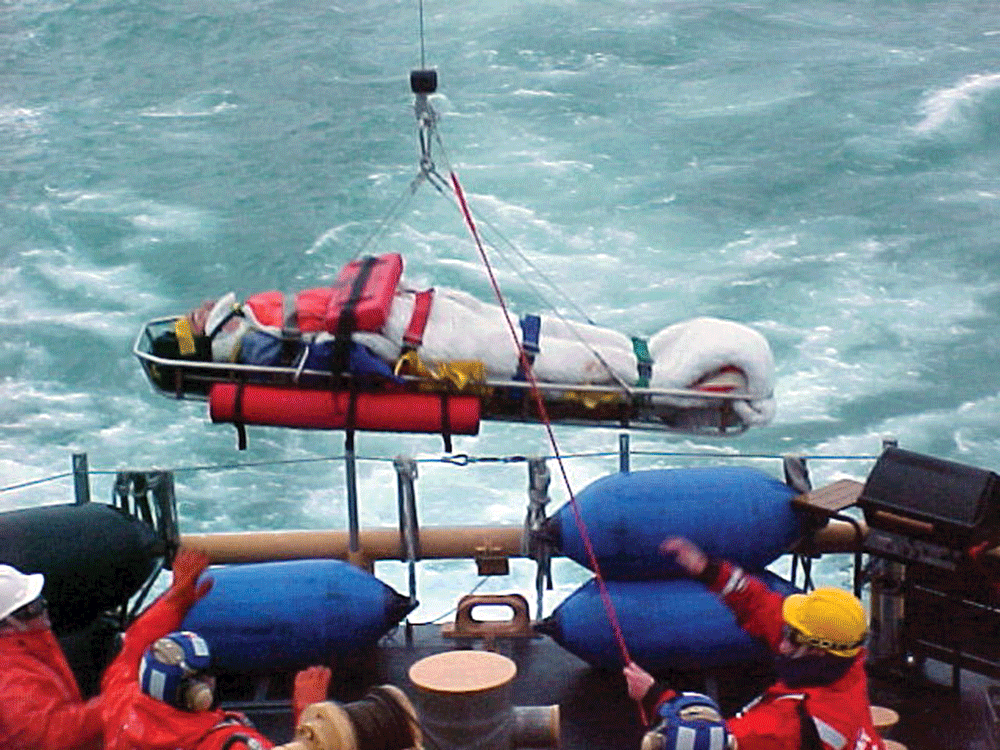
“I AM LESS AN INDIVIDUAL THAN PART OF A CONTINUUM, JOINED TO ALL THINGS AND DRIVEN BY THEM MORE THAN I AM IN CONTROL OF MY OWN PATH.”
The first step to doing this successfully is careful breathing, as panic and hyperventilation are dangers. Regular deep breaths with complete exhalation are important. Some Naval instructors tell their students to make the letter “K” in their mouths with their lips closed which keeps a small amount of air in the nostrils and can thusly keep water from entering when submerged. It is important to also make certain everyone at sea has access to a personal flotation device. However, if one is not present, clothing – specifically pants – can be a useful alternative. Tying the legs together, air can then be scooped, orally delivered, or splashed into the pants. The legs of the pants should then be placed over the neck of the swimmer, with the waist secured to the swimmer via a belt. As long as the pants or trousers are wet they should remain airtight, so they must be periodically moistened or refilled with air. To contain body heat while using a flotation device, use the Heat Escape Lessening Posture (or H.E.L.P.) which means crossing the ankles while keeping knees raised and arms tucked in to the body.
SEA LIFE
If a vessel might sink or is sinking, the scenario changes. Knowing the wildlife you may encounter in a given part of the world is an important part of survival. Many people feel that the most significant danger you might face is from a carnivorous predator, such as the many species of shark that live in virtually every part of the ocean. However, a common threat to many ocean-going vessels are whales. Two famous cases of shipwreck survivors, that of Steven Callahan in 1982 and the instance of Bill and Simone Butler in 1989, were most likely the cause of whales. Callahan in the Atlantic Ocean and the Butlers in the Pacific, both had holes punched in the hull of their sloops, the Butlers likely by pilot whales. This demonstrates that it is also important to know the appropriateness of your sailing vessel for the type of journey you are on. Trans- Atlantic and Trans-Pacific cruises become that much more dangerous on a smaller craft – although if you are an adventurer this may in fact be the point of the trip. Just be aware of the additional threat.
The greatest danger related to the holing of a sailing craft generally comes in the evenings or in bad weather when you are either asleep or visibility is poor. If possible, it is wise to post a watch, which would allow you to be aware of both wildlife and human predators. In both of the above cases, the encounter with the whales occurred at night and in bad weather, which may or may not have been prevented by the use of a watch posting. Callahan was sailing alone.
-ADVERTISEMENT-
If your craft does have a hole or leaks for any reason, you can alert yourself to the problem using a bilge alarm or high-water alarm. Once their craft began to sink, the Butlers kept their heads – they grabbed the gear they needed and jumped into an emergency raft. In their case, they only had time to grab the absolute essentials – fishing rods and a salt water purifier. In general, the water purifier is more important, as there are instances of individuals surviving up to eight weeks or more without food. In some cases, exposure to extreme heat without replacing fluids can kill a person in hours. Understandably in this case, shelter is also important as the elements can also kill you over time due to hypothermia (when the body’s temperature drops too low) or hyperthermia (when the body’s temperature climbs too high).
The Butlers were able to survive by eating raw fish caught with their fishing poles and drinking the purified water from the salt water purifier. Even carefully minding the resources they were able to produce, they lost a significant amount of weight over the course of their 66 day ordeal. They were rescued by a Costa Rican Coast Guard vessel. Callahan’s case is distinct in that he designed and built the vessel he sailed in, so when it struck what was most likely a whale during a night storm it only swamped but did not sink due to watertight compartments he engineered into the hull of the craft. Before rough seas separated him from his craft, he was able to retrieve a number of items, including a spear gun he used to hunt and two solar stills he used to purify the salt water. Solar stills essentially function on the greenhouse effect, using sunlight to steam salty or even brackish water to purify it. Callahan also fetched some items that he was able to use to collect rain water, such as plastic sheeting. He had to live on just over a pint of water a day.
It is possible to also drink the blood of turtles, birds, or other creatures if no water is available.
Callahan was able to survive for as long as he did because he very carefully managed his resources. In order to get enough food to eat, he developed a kind of ecosystem around his 6- foot life raft. Birds would eat the left over elements of the fish, barnacles, and even other birds he was able to catch. In fact, it was ultimately the cloud of birds around his raft that showed fisherman where to find him off the coast of Guadeloupe. He’d lost approximately one-third of his bodyweight.
What was important in Callahan’s case is that he had a buoyant and highly visible emergency kit on hand whose contents included many of the following items that a survivalist would need: a registered emergency beacon, a handheld VHF radio, a selection of flares and smoke signals, a strobe light, a whistle, a signal mirror, as much water as possible, emergency rations, essential medications, a first aid kit, a solar still or purifier, a patch kit, a knife, a solar blanket, fishing gear, sunscreen, bailer, paper and pen in a zip lock bag, spare prescription glasses or sunglasses and binoculars.
SIGNAL FOR HELP
A key feature of survival is making certain that when a vessel comes within sight, you can signal it in some way so it can rescue you. It is location as well, and having a map of some kind that indicates shipping lanes is very helpful. If the vessel’s current location is such that traffic will be too low to find the life raft, navigating the craft to the shipping lanes may promote survival.
This graphic depicts the approximate location of a vessel in distress and the potential search areas plotted by the Coast Guard Sector Honolulu Command Center, Aug. 12, 2014. A man was rescued from a life raft after his 41-foot sailboat sank seven miles south of Diamond Head, Oahu.
Consider the case of Dougal Robinson and his family, who survived at sea for 38 days. The family’s 43-foot wooden schooner was holed by a pod of killer whales west of the Galapagos Islands – by now it should be clear to view whales only from a distance. The Robinsons were able to board their life raft, grab their emergency kit, and attach a dingy to the raft. From materials salvaged from the sinking ship, Robinson built a sail that he used to guide the family toward nearby shipping lanes. Improvised sails can be made from materials as simple as plastic sheeting and string or rope. Dougal’s wife – a former nurse – devised a way to stretch out the turtle blood and old water that was turning and becoming poisonous. She devised a system to give the family members enemas using tubes from a ladder that permitted a modicum of hydration. Their life raft eventually failed after 16 days and they were forced to board the dingy. Using prevailing winds and currents, they were able to approach the Panama Canal shipping lanes where they were sighted by a fishing trawler heading for the canal. Robinson had the foresight to bring along flares he used to signal the ship. While remaining a primitive form of signaling, flares can still be used effectively to achieve the goal of being sighted. Mayday signals can also be broadcast on VHF channel 16 or via HF frequency 2182. Orange smoke, red flares, or launching distress rockets are other means of signaling for help.
“A LIFE RAFT IS NOT A SAILING VESSEL, HOWEVER PORTRAYED IN THE SALES LITERATURE; IT IS MERELY A SET OF RUBBER TUBES WITH THE SOLE PURPOSE OF KEEPING SURVIVORS OUT OF THE WATER UNTIL RESCUE.”
As for Steven Callahan, an experienced sailor and Naval Architect, his Emergency Position Indicating Radio Beacon (EPIRB) was intended to signal nearby craft, whether ships or planes, but he was in such an isolated part of the ocean no shipping lanes were close enough to support rescue. Because this wreck occurred in the 1980s the EPIRB was not being monitored by satellite, and no vessel noticed the many flares he brought with him. Modern day EPIRB units communicate via satellite, but also may contain a GPS device allowing rescuers to locate you within 50 feet. For Callahan, his many emergency preparations did not speed his rescue but they did allow him to stay alive. Even if attempts to get noticed and rescued fail, maintaining discipline of resources and staying as healthy as possible for as long as possible are key. Methods of signaling ships can also take the form of international signal flags showing NC, a square flag having above it or below it a ball (or anything resembling a ball), or raising or lowering arms outstretched to each side.
“BEFORE DEPARTING ON ANY TRIP, TAKE THE TIME TO REVIEW YOUR WATERCRAFT AND UNDERSTAND ITS CAPABILITIES IN RELATION TO THE AREA YOU INTEND TO TRAVEL INTO. CAN IT HANDLE THE TRAFFIC, TIDES, AND WAVES? IF YOU ARE UNCERTAIN ABOUT YOUR CRAFT’S CAPABILITIES, IT MAY BE BEST TO STAY HOME.”
Never give up. A recurring theme in virtually every story of survival, these three words indicate the single most critical factor in surviving an emergency at sea. Maintaining the discipline to carefully administer your resources, to keep your head if you fall in the water, to acquire food and water by any means necessary, and to work tirelessly to reach rescuers is not an easy thing. The will to live and to endlessly power through under dire conditions is what kept these survivors alive. Dig down deep, keep your head and never ever give up. These are the key tenets of ocean survival.
An Interview with Lt. Colonel Robert Bateman
It is said that an ounce of prevention is worth a pound of cure. While having the skills to survive a disaster are important, perhaps more important is the ability to prevent that disaster in the first place. Lt. Col. Robert Bateman (ret.) is a prolific author and a recently retired military officer. Bateman won the 2004 Colby Award for military history for his book No Gun Ri: A Military History of the Korean War Incident. His thoughts on preventing disasters at sea are below.
- Lt. Col. Bateman, you are currently sailing across the Eastern Seaboard of the United States with your wife and child and various crew members in a 47 foot Beneteau 473. What prompted your decision to make this journey?
During my last tour in Afghanistan, 2011-2012, I realized that I was getting a little long in the tooth to be doing what I’d been doing for more than 20 years. That was when I made the decision to retire sometime in the next couple of years. That made me wonder, as most career soldiers must at some point, “What am I going to do when I grow up?” After a while I decided that “growing up” (in other words, wearing a suit and a tie) was not really my preferred way of life. From there it was a short intellectual journey to what I am doing now, sailing and writing military history. In this case I realized that most military historians ignore the sea, and most maritime/naval historians ignore the land and the coast. Almost nobody has written about America’s intimate relationship with the sea and her own coastal defenses in any sort of comprehensive manner, and to do that the right way I would need to see the coast from the sea myself, preferably from the deck of a sailboat. So that is what I am doing. It helps a little that I already had a little more than 10,000 miles of sailing experience before I set out.
- Obviously a person sailing that distance with their family has a serious interest in preventing the kinds of at-sea incidents that our readership prepares for. How do you go about preventing these incidents? You know that old joke, “You’re not being paranoid if somebody really is trying to kill you”?
Well, after 25 years in the infantry that has become sort of ingrained in my DNA. So my first line of defense is information, I am an obsessive about wind, waves, barometric pressure readings, and NOAA data files and forecasts. The best way to survive a storm is not to find yourself in a storm in the first damned place.
After that, aboard the boat it is all about redundancy. I found in the last several years as I would be walking around marinas ogling OPBs (Other People’s Boats) that I had become what I call an “anchor snob.” Most boats do not have serious anchors, or even appropriate anchors. I would walk around and judge the owners based upon the weight and design of what they were carrying on the bow. One undersized anchor? Yea, he’s not serious and may be a danger to himself and others. One sufficient or oversized anchor? OK, he is probably at least competent, but not really a long-distance guy, probably just stays local and sails on the weekends. Two anchors, oversized, with a heavy-duty windless to bring them up? My kind of sailor. As for myself, my primary anchor is 200% oversized with an all-chain rode, my secondary is 175% with half chain, and disassembled in the bilge I have a third anchor and anchor chain of an entirely different design for different conditions or emergencies.
It is the same way with my navigation and charts. Of course on my chart plotter I have all the most current data chips, but then in addition to that I purchased paper charts for the entire US East Coast, and I have downloaded every NOAA chart for the Western Hemisphere onto my phone and my laptop … and I have a second laptop with those same charts. In other words, I have five different sets of the same data. You know, just in case.
Even I admit, however, that I might be a little excessive with my pumps. The bilge pump is what takes water out of your hull because, well, if it does not that is what we sailors call “sinking.” I have a primary pump in my center bilge compartment which is automatic. It’s pretty much like the average sump pump in your house. Then I have another, of nearly the same design, in the aft bilge, which is also pretty normal and stock. But then I bought a third electric pump and wired it with 30 feet of cable attached to alligator clips and a 20-foot hose. That one I can take to any part of the boat and throw it in where there may be flooding and it will gush out 1,500 gallons per hour down that hose and out one of my portholes. Then, I also have three hand pumps as well. One is built into the hull and the other two can be located wherever they need to be.
So yea, maybe a bit much, but hey, this is my house and my wife and daughter are on-board. Can you blame me if I have replacements for the replacements of the replacements? After all, there is always something that will go wrong, and if it goes too wrong, my house sinks.
- Is there any particular type of gear or equipment you recommend to promote the safety of your vessel and your crew and family?
Since I do a lot of offshore sailing, which also means I’m sailing 24/7 at times, life preservers are essential. I carry enough for seven adults and two children, and at night anyone topside in the cockpit must be wearing one. Further, each evening I rig what are called “jack lines” fore to aft along the sides of my deck. These are about the equivalent to 10,000 lb nylon towing cables. If anyone leaves the cockpit to go forward at night they must clip into these lines with a tether. The life jackets have an integrated harness built in.
Finally, there is the life raft and my “ditch bag.” Mine is, naturally, rated for the open ocean and can comfortably hold six people. It has a double insulated bottom (helps when the water is cold), and contains food, water, fishing gear, and signal gear. In my ditch bag I keep a supplemental GPS, plus a sextant, an EPRIB (a satellite communications device which is registered to my boat and sends position via satellite for a long time after it is activated), and a whole lot more signaling devices (flares, smoke, sea dye, signal mirror, hand-held VHF, etc.) in addition to some clothing, some food, and some additional water. As the saying goes, one always steps UP into a life raft (meaning you don’t abandon your boat until your boat abandons you, vertically), and the last thing I grab before climbing up out of my boat is that ditch bag.
Movies, Books and Documentaries about Survival at Sea: if you are interested in further reading on the subject, here are a few sources that may help you to learn more technique and methods.
Survive the Savage Sea (1992) – This film is based on the true story of a family that fulfills their lifelong dream of purchasing a yacht only to have if sink shortly after purchase. The life raft they purchased was far too small for the number of people aboard the vessel. This is the story of their attempt to survive after the sinking.Solo: Lost at Sea (2008) – This is the story of Andrew McAuley, an Australian adventurer who attempted the crossing from Tasmania to New Zealand in a solo kayak. He spent a month at sea before his story ended in tragedy. His preparations, while quite extensive, were not quite enough to keep him alive. His vessel was recovered but he was not.Shackleton’s Antarctic Adventure (2001) – This documentary details the true story of Sir Ernest Shackleton, who attempted to conduct the world’s first Trans-Arctic Expedition. Unfortunately his ship, the Endurance, became trapped in the ice and was eventually crushed. A testament to the will of man, all 28 men survived almost two years in the absolutely inhospitable climate of the Antarctic.Cast Away (2000) – This film is the fictionalized account of a FedEx employee who boards an ill-fated flight. After the crash, he washes up on the shore of a deserted island and is forced to use the materials of the plane that wash up on the beach, as well as the scant resources that are available to him on the island, to survive.